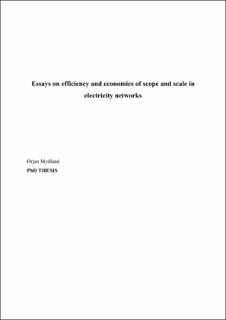Essays on efficiency and economies of scope and scale in electricity networks
Doctoral thesis
Permanent lenke
https://hdl.handle.net/11250/2640857Utgivelsesdato
2018-12Metadata
Vis full innførselSamlinger
Sammendrag
The electricity market in Norway has undergone substantial changes in recent decades, which
prompts the need for research on how the industry should be organized. In an indivisible
electricity industry that, on the one side, consists of market-oriented competitive entities in
production and power trading, and, on the other side, natural monopolies within transmission
and distribution, it is of interest to perform cost analysis within the productivity and efficiency
framework. The electricity industry is complex, owing to the fact that production and
consumption must happen simultaneously. After the Energy Act of Norway came into force on
January 1, 1991, only transmission and distribution remained regulated. The regulation of
transmission and distribution serves to avoid the typical disadvantages arising from natural
monopolies. Many countries have gone through the same or similar changes in their respective
industries. In a developing and increasingly global industry regarding power trading, more
regulation is probably needed, not less. The possible future changes in the power grid—owing
to private firms and the ability of households to take advantage of the technological
developments in solar and wind generation—will probably also affect the regulating task in the
future. The main objective of this thesis is to improve the understanding of efficiency measures
and methods, and to increase the knowledge of the market structure in the Norwegian electricity
distribution industry.
In Essay 1 “Economies of scale in Norwegian electricity distribution: A quantile regression
approach”, we investigate scale economies to see if the structure of the industry affects the
costs. If a restructure of the industry would reduce costs for the firms, and, hence, in the
industry, it would mean increased productivity and efficiency. In Essay 2, “Economies of Scope
and Scale in the Norwegian Electricity Industry”, we study scale and scope economies.
Economies of scope measures the synergies of producing more than one output. Some
electricity companies in Norway both generate and distribute electricity. If there exist some
positive synergies from producing more than one output, it means that the cost would be higher
if two separate firms produced the same amounts of output of each product as the one firm
producing both products. In Essay 3, “Lost economies of scope and potential merger gains in
the Norwegian electricity industry”, I investigate what are the potential gains from merging the
distribution companies in Norway. Both Essay 1 and Essay 2 state that there are economies of
scale in the industry, meaning that the industry would benefit from increasing the size of the
companies in terms of increased output. Because the output is given, this means that companies
must merge. In Essay 2, we report that there exist economies of scope. Due to the change in the
Energy Act of Norway in 2016, we find that the separation of the integrated firms producing
both generation and distribution services, would increase costs to the industry and, hence, incur
losses by not utilizing economies of scope. If disentangling generation and distribution of
electricity would lead to more mergers of the distribution companies, it is of interest to seek the
potential gains in terms of cost reductions to the industry from such mergers. In Essay 4
“Disentangling Costs of Persistent and Transient Technical Inefficiency and Input
Misallocation: The Case of Norwegian Electricity Distribution Firms”, we focus on the fact that
many efficiency studies neglect allocative efficiency, and only concentrate on technical
efficiency. In addition, we also disentangle costs of persistent and transient inefficiency, and
include determinants for both persistent and transient inefficiency.
